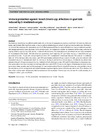Please use this identifier to cite or link to this item:
https://accedacris.ulpgc.es/jspui/handle/10553/114067
| Title: | Immunoprotection against mixed Eimeria spp. infections in goat kids induced by X-irradiated oocysts | Authors: | Barba, Emilio Guedes Santana, Aranzazu Del Carmen Molina Caballero, José Manuel Martín Martel, Sergio Muñoz Ojeda, María Del Carmen Ferrer Quintana, Otilia Rosa Lara, Pedro Carlos Hermosilla, Carlos Taubert, Anja Ruiz Reyes, Antonio |
UNESCO Clasification: | 240112 Parasitología animal 310904 Medicina interna |
Keywords: | Eimeria Spp Goats Immunoprotection Vaccine X-Rad Attenuation |
Issue Date: | 2022 | Project: | Ensayos de Vacunación Frente A Coccidiosis Caprina Mediante El Empleo de Coquistes Atenuados Por Irradiación. | Journal: | Parasitology Research | Abstract: | Strategies to control goat coccidiosis traditionally rely on the use of management practices combined with anticoccidial treatments, and limited effort has been made, so far, to address immunological control of caprine Eimeria infections. Previously, we showed that monospecific immunization with X-Rad-attenuated Eimeria ninakohlyakimovae oocysts induced considerable immunoprotection upon challenge. In the present study, we conducted a similar vaccination trial but using a mixture of caprine Eimeria species typically present in natural infected goats. For immunization, sporulated oocysts were attenuated by X irradiation (20 kilorad). All infections were performed orally applying 105 sporulated oocysts of mixed Eimeria spp. per animal. In total, 18 goat kids were grouped as follows: (G1) immunized + challenge infected; (G2) primary + challenge infected; (G3) challenge infection control; and (G4) non-immunized/non-infected control. Overall, goat kids infected with attenuated oocysts (= immunized) shed less oocysts in the faeces and showed a lower degree of clinical coccidiosis than animals infected with non-attenuated oocysts. Animals of both challenge groups (G1 and G2) showed partial immunoprotection upon reinfection when compared to challenge infection control (G3). However, the degree of immunoprotection was less pronounced than recently reported for monospecific vaccination against Eimeria ninakohlyakimovae, most probably due to the complexity of the pathogenesis and related immune responses against mixed Eimeria spp. infections. Nevertheless, the data of the present study demonstrate that immunization with attenuated Eimeria spp. oocysts may be worth pursuing as a strategy to control goat coccidiosis. | URI: | https://accedacris.ulpgc.es/handle/10553/114067 | ISSN: | 0932-0113 | DOI: | 10.1007/s00436-022-07465-z | Source: | Parasitology Research [ISSN 0932-0113], n. 121, p. 1517–1525 |
| Appears in Collections: | Artículos |
SCOPUSTM
Citations
3
checked on Jun 8, 2025
WEB OF SCIENCETM
Citations
3
checked on Jun 8, 2025
Page view(s)
98
checked on Mar 16, 2024
Download(s)
56
checked on Mar 16, 2024
Google ScholarTM
Check
Altmetric
Share
Export metadata
Items in accedaCRIS are protected by copyright, with all rights reserved, unless otherwise indicated.
